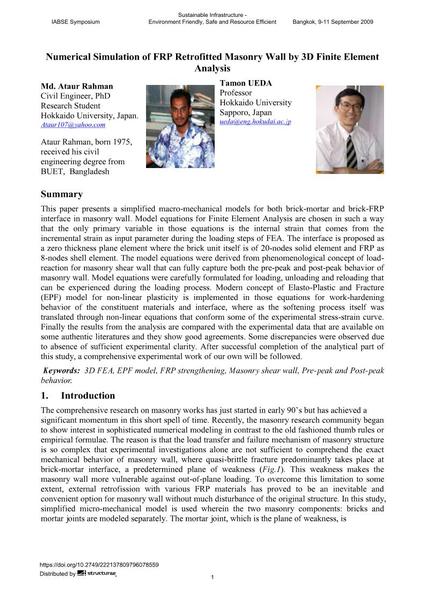Numerical Simulation of FRP Retrofitted Masonry Wall by 3D Finite Element Analysis

|
|
|||||||||||
Bibliografische Angaben
| Autor(en): |
Md. Ataur Rahman
Tamon Ueda |
||||
|---|---|---|---|---|---|
| Medium: | Tagungsbeitrag | ||||
| Sprache(n): | Englisch | ||||
| Tagung: | IABSE Symposium: Sustainable Infrastructure - Environment Friendly, Safe and Resource Efficient, Bangkok, Thailand, 9-11 September 2009 | ||||
| Veröffentlicht in: | IABSE Symposium Bangkok 2009 | ||||
|
|||||
| Seite(n): | 114-125 | ||||
| Anzahl der Seiten (im PDF): | 10 | ||||
| Jahr: | 2009 | ||||
| DOI: | 10.2749/222137809796078559 | ||||
| Abstrakt: |
This paper presents a simplified macro-mechanical models for both brick-mortar and brick-FRP interface in masonry wall. Model equations for Finite Element Analysis are chosen in such a way that the only primary variable in those equations is the internal strain that comes from the incremental strain as input parameter during the loading steps of FEA. The interface is proposed as a zero thickness plane element where the brick unit itself is of 20-nodes solid element and FRP as 8-nodes shell element. The model equations were derived from phenomenological concept of load- reaction for masonry shear wall that can fully capture both the pre-peak and post-peak behavior of masonry wall. Model equations were carefully formulated for loading, unloading and reloading that can be experienced during the loading process. Modern concept of Elasto-Plastic and Fracture (EPF) model for non-linear plasticity is implemented in those equations for work-hardening behavior of the constituent materials and interface, where as the softening process itself was translated through non-linear equations that conform some of the experimental stress-strain curve. Finally the results from the analysis are compared with the experimental data that are available on some authentic literatures and they show good agreements. Some discrepancies were observed due to absence of sufficient experimental clarity. After successful completion of the analytical part of this study, a comprehensive experimental work of our own will be followed. |
||||
